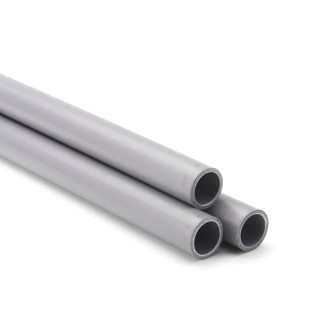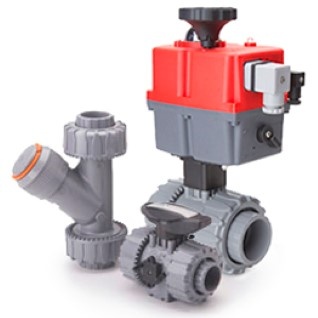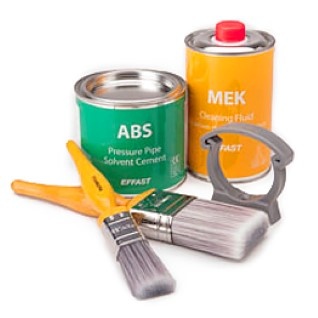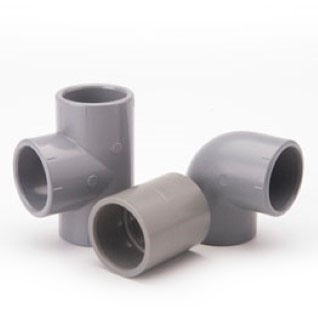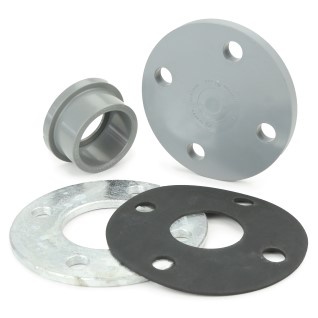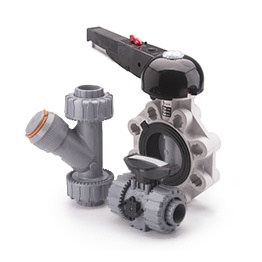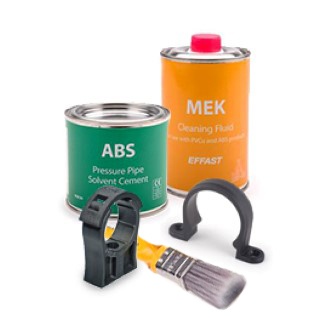- Home
- ABS
ABS
ABS, or acrylonitrile butadiene styrene, is extremely sturdy against impact, has good chemical resistance and is non-toxic, making it extremely versatile and suitable for potable water and chilled process water applications.
ABS has been proven to be resistant to a wide range of diluted inorganic acids, organic acids, salts, animal fats and certain oils. However, it is not resistant to organic solvents, alcohol, petrol, acetic acid or any vegetable oils.
The smooth bore resists limescale build-up, gives superior flow, is abrasion resistant and corrosion free, and because ABS contains no metallic stabilisers, it is also ideal for conveying high purity de-ionised water.
We stock a massive selection of ABS Inch Pipe & ABS Metric Pipe including a full range of fittings and accessories.
| Pressure Rating | 9 to 15 bar |
| Operating Temperature | -40°C to 70°C |
| Standards | British Industrial Biological Research Association Code of Practice for Food Usage 45/5, BS 5391, BS 5392 Part 1, BS 21, DIN 2999, ISO7 |
Approvals:
 |
WRAS approved (where applicable) |
 |
BSI Kitemark approved (where applicable) |
Dimensions For ABS Pipe
ABS Inch Pipe Class C Dimensions
| Nominal Size (inch) | Average Outside Diameter (mm) | Average Bore Inside Diameter (mm) | Average Wall Thickness (mm) |
| 1 | 33.6 | 29.6 | 2.0 |
| 1 1/4 | 42.3 | 37.3 | 2.5 |
| 1 1/2 | 48.3 | 42.6 | 2.9 |
| 2 | 60.4 | 53.3 | 3.6 |
| 2 1/2 | 75.2 | 68.0 | 3.6 |
| 3 | 88.9 | 78.6 | 5.2 |
| 4 | 114.3 | 101.5 | 6.4 |
| 5 | 140.2 | 126.8 | 6.7 |
| 6 | 168.3 | 148.5 | 9.9 |
| 8 | 219.1 | 193.7 | 12.7 |
ABS Inch Pipe Class E Dimensions
| Nominal Size (inch) | Average Outside Diameter (mm) | Average Bore Inside Diameter (mm) | Average Wall Thickness (mm) |
| ½ | 21.4 | 17.4 | 2.0 |
| ¾ | 26.8 | 21.8 | 2.5 |
| 1 | 33.6 | 27.3 | 3.2 |
| 1¼ | 42.3 | 34.4 | 4.0 |
| 1½ | 48.3 | 39.2 | 4.6 |
| 2 | 60.4 | 49.2 | 5.6 |
| 2½ | 75.2 | 64.0 | 5.6 |
| 3 | 88.9 | 72.4 | 8.3 |
| 4 | 114.3 | 93.1 | 10.6 |
ABS Inch Pipe Class T Dimensions
| Nominal Size (inch) | Average Outside Diameter (mm) | Average Bore Inside Diameter (mm) | Average Wall Thickness (mm) |
| ½ | 21.4 | 14.2 | 3.6 |
| ¾ | 26.8 | 19.6 | 3.6 |
| 1 | 33.6 | 24.9 | 4.4 |
| 1¼ | 42.3 | 31.7 | 5.3 |
| 1½ | 48.3 | 36.3 | 6.0 |
| 2 | 60.4 | 46.0 | 7.2 |
If you require any further information, our excellent customer service team is here to help so please call us on 01794 835835.



Introduction to ABS Pressure Pipe
ABS pressure pipe is a high-performance thermoplastic piping system designed for pressurised fluid applications. Known for its lightweight, impact resistance, and excellent low-temperature performance, ABS pressure pipe is widely used across industrial, water treatment, compressed air, and food processing applications.
At Pipestock, our ABS pressure pipe range is available in Class C, Class E, and Class T, with pressure ratings up to 15 bar at 20°C, conforming to BS 5391 standards. It is WRAS-approved for potable water use up to 23°C, making it a reliable choice for safe fluid handling.
ABS pressure pipe is joined using a solvent welding process, creating strong, leak-free connections without the need for additional fittings or tools. Its corrosion resistance and durability make it ideal for industries requiring chemical resistance, low-maintenance operation, and easy installation.
Explore our range of ABS pressure pipes and fittings to find the right solution for your application.
What does ABS stand for?
ABS stands for Acrylonitrile Butadiene Styrene. It is a thermoplastic polymer known for its durability, impact resistance, and lightweight properties, making it an ideal choice for various piping applications.
What is ABS pipe made from?
ABS pipe is made from Acrylonitrile Butadiene Styrene (ABS) resin, which is a combination of three monomers:
- Acrylonitrile – Provides chemical resistance and strength.
- Butadiene – Adds toughness and impact resistance.
- Styrene – Enhances rigidity and gives the material a smooth, glossy finish.
Is ABS known by any other names?
ABS is generally referred to as ABS plastic or ABS piping, but there are no widely used alternative names for ABS in the context of piping.
What is ABS pipe used for?
ABS pipe is used in a variety of industries and applications, including:
Industrial & Chemical Processing
- Used for handling corrosive and non-corrosive chemicals in manufacturing plants.
- Resistant to diluted inorganic acids, salts, and some organic acids.
- Suitable for low-temperature chemical transport where PVC or metal pipes may become brittle.
Compressed Air Systems
- Frequently used in low to medium-pressure compressed air networks.
- High impact resistance reduces the risk of cracking under mechanical stress.
- Lighter than metal alternatives, making installation easier and more cost-effective.
Food & Beverage Processing
- Non-toxic and WRAS-approved for specific potable water applications.
- Complies with British Plastic Federation and EEC food safety standards.
- Used for water distribution and ingredient handling in food production facilities.
Water Treatment & Sewage Processing
- Commonly used in water treatment plants for transporting treated and untreated water.
- Resistant to bacterial and chemical buildup, reducing maintenance requirements.
- Suitable for chlorinated water and wastewater applications.
Cooling & Refrigeration Systems
- Handles chilled water distribution in HVAC and refrigeration systems.
- Performs well in low-temperature environments (operating range: -40°C to +70°C).
- Maintains flexibility and strength where PVC or metal alternatives may crack.
Marine & Aquaculture Applications
- Used in seawater handling systems due to corrosion resistance.
- Suitable for fish farms, aquariums, and saltwater processing facilities.
Agricultural Irrigation & Fertigation
- Used for pumping and distributing water in controlled irrigation systems.
- Resistant to fertiliser chemicals and agricultural treatment solutions.
- Lightweight and easy to install for both above-ground and buried irrigation networks.
How is ABS pipe measured?
ABS pipes are measured by their outside diameter (OD) and come in both imperial and metric sizes.
What fittings can be used on ABS pipe?
ABS pipe is designed to be used with solvent weld fittings, which create a strong, permanent bond by chemically fusing the pipe and fitting together. Unlike some other plastic pipe systems, compression fittings & push-fit fittings are not suitable for ABS pipe due to its material properties and installation method.
How do I cut ABS pipe?
To cut ABS pipe effectively:
- Use a fine-tooth saw or pipe cutter to achieve a clean cut.
- Ensure the cut is straight to allow for a secure joint.
- Remove burrs and rough edges with sandpaper or a deburring tool to ensure a smooth connection.
We recommend using the Milwaukee PVC & ABS Saw.
How do I join ABS pipe together?
Joining ABS pipe together requires a solvent welding process, which chemically fuses the pipe and fitting to create a strong, leak-proof joint. This method ensures a permanent bond that maintains pressure integrity in industrial and commercial applications. Below is a detailed step-by-step guide for properly joining ABS pipe.
Step 1: Cutting the Pipe
Tools Needed: Fine-tooth saw, pipe cutter, or plastic pipe saw.
Process:
- Cut the ABS pipe squarely at a right angle to its axis to ensure a proper fit inside the fitting.
- Deburr the cut end using a scraper or knife to remove rough edges that could affect the joint seal.
Step 2: Chamfering the Pipe End
Tools Needed: Chamfering tool, fine disc angle grinder, file, or abrasive paper (80-100 grit).
Process:
- Chamfer the outside edge of the pipe at 15°-30°.
- This chamfering prevents the solvent cement from being wiped off during insertion and ensures a proper seal.
| Pipe Size | Chamfer Size |
| 3/8” (16mm) | 2mm |
| ½” - 1½” (20 - 50mm) | 3 - 4mm |
| 2” - 8” (63 - 225mm) | 5 - 6mm |
Step 3: Marking the Insertion Depth
Tools Needed: Marker pen.
Process:
- Measure and mark the pipe at a distance equal to the depth of the fitting socket plus 5mm.
- This serves as a visual reference to ensure the pipe is fully inserted into the fitting.
Step 4: Cleaning & Preparing the Surfaces
Tools Needed: Lint-free cloth, absorbent paper, Effast ABS solvent cleaner.
Process:
- Roughen the pipe surface up to the insertion depth using abrasive paper (80-100 grit).
- Clean both the pipe end and the fitting socket with a lint-free cloth dampened with Effast solvent cleaner.
- Do not over-roughen the pipe, as excessive material removal can increase the joint clearance.
Step 5: Applying Solvent Cement
Tools Needed: Effast ABS solvent cement, brush (half the diameter of the socket).
Process:
- Select the correct solvent cement for ABS (Effast ABS solvent cement).
- Apply a thin, even layer of solvent cement to both the pipe and inside of the fitting socket.
- Avoid excess cement, as too much can weaken the joint.
Step 6: Assembling the Joint
Process:
- Insert the pipe into the fitting socket immediately while the cement is still wet.
- Do not twist the pipe while inserting. Simply push it straight in until it reaches the marker line.
- Hold the joint in place for the specified holding time to allow the cement to bond:
Pipe Size Holding Time (Minutes) 3/8” - 2” (16mm - 63mm) ½ min 2½” - 4” (75 - 119mm) ¾ min 5” - 8” (140 - 225mm) 1 min - A small bead of solvent cement should form around the joint, indicating a proper seal.
- Wipe away excess solvent cement immediately using a clean cloth.
Step 7: Curing Time
Process:
- Allow the joint to set undisturbed for at least 10-15 minutes before handling.
- The curing time for pressure resistance is as follows: Up to 8” (225mm) - 8 hours (for handling), 24 hours (full pressure testing)
- At temperatures below 5°C, the curing time will be significantly longer.
- Do not seal the system immediately, as solvent vapours must dissipate to avoid damage.
Key Considerations for a Strong Joint
- Use only Effast ABS solvent cement – using incorrect cement may weaken the bond.
- Work in a well-ventilated area – solvent cement releases fumes that can be hazardous.
- Avoid making joints in wet or damp conditions – moisture can compromise the bond.
- Do not thin solvent cement – using cleaner as a thinner reduces joint strength.
- Support heavy components – valves, strainers, or other fittings should not stress the joint.
If you need to connect ABS to another material like PVC, a mechanical coupling should be used instead of standard ABS solvent cement.
Is ABS pipe safe for drinking water?
ABS pipe and fittings supplied by Pipestock are WRAS-approved for potable water applications, meaning they have been tested for safety in contact with drinking water.
ABS Pipe WRAS Material Approval:
- Approval Number: 250255001
- Section: 5020 Acrylonitrile Butadiene Styrene Copolymer (ABS)
- Use: Approved for contact with potable water up to 23°C
ABS Fittings WRAS Product Approval:
- Approval Number: 2306055
- Section: 1180 Fittings for use with Tube and Pipe
- Use: Approved for use with ABS pipe complying with BS EN 5391-2006
- Maximum Working Pressure: 15 Bar
- Maximum Operating Temperature: 23°C
ABS Solvent Cement WRAS Material Approval:
- Approval Number: 240855009
- Section: 5560 Solvent Cements
- Use: Approved for joining ABS pipe and fittings under specified cure conditions
- Curing Requirement: 24 hours @ 7°C
- Maximum Operating Temperature: 23°C
However, while the materials and fittings themselves are approved, full WRAS system approval (including installation methods) may be required for compliance in potable water installations. If using ABS for drinking water applications, ensure that all components and installation practices meet the necessary regulatory standards.
What is the difference between ABS & PVC pipe?
When selecting a plastic pressure pipe system, it’s essential to understand the differences between ABS (Acrylonitrile Butadiene Styrene) and PVC (Polyvinyl Chloride) pressure pipes. Both materials are widely used in industrial and fluid handling applications, but they have key distinctions in performance, durability, and suitability for different environments.
1 - Material Composition & Colour
- ABS Pressure Pipe – Light grey (RAL 7046), rigid, impact-resistant thermoplastic.
- PVC Pressure Pipe – Commonly dark grey for industrial use; rigid but slightly more flexible than ABS.
2 - Strength & Pressure Ratings
| Feature | ABS Pressure Pipe | PVC Pressure Pipe |
| Pressure Rating | Class C: 9 bar at 20°C | Class E: 15 bar at 20°C | Class T: 12 bar at 20°C | Varies by class; commonly 9 to 16 bar at 20°C |
| Impact Resistance | High – withstands impacts well | Moderate – more brittle under impact |
| Tensile Strength | Moderate | Higher than ABS |
3 - Temperature & Thermal Expansion
| Feature | ABS Pressure Pipe | PVC Pressure Pipe |
| Temperature Range | -40°C to +70°C | 0°C to +60°C |
| Thermal Expansion Coefficient | 10.1 x 10⁻⁵ m/m°C | 5.5 x 10⁻⁵ m/m°C |
Key Takeaway: ABS performs better at low temperatures, while PVC has a lower thermal expansion rate, meaning it moves less with temperature changes.
4 - UV Resistance & Outdoor Suitability
- ABS is not UV-resistant and should be protected from prolonged sun exposure.
- PVC has better UV resistance, making it more suitable for outdoor applications.
5 - Joining Methods & Installation
The key difference between ABS & PVC jointing is the type of solvent cement that is used. Always use Effast ABS solvent cement for ABS pipes and Effast PVC solvent cement for PVC pipes.
The Effast Cleaning Fluid can be used on both ABS & PVC pipe.
6 - Chemical Resistance
Both materials have good resistance to a variety of chemicals, but with some key differences:
- ABS resists diluted inorganic acids, salts, and animal fats/oils. It is not resistant to organic solvents, alcohol, petrol, or vegetable oils.
- PVC has broader chemical resistance, including some organic solvents, but is more brittle under impact.
7 - Applications & Suitability
| Application | ABS Pressure Pipe | PVC Pressure Pipe |
| Industrial Fluids | Commonly used (handles oils, greases, or some hydrocarbons better than PVC) |
Commonly used (handles strong acids, alkalis, or chlorinated water better than ABS) |
| Outdoor Installations | Not suitable | More suitable |
| Potable Water | WRAS-approved | WRAS-approved |
Which Should You Choose?
- Choose ABS Pressure Pipe if you need a high-impact resistant, low-temperature-performing system, especially for industrial applications and compressed air.
- Choose PVC Pressure Pipe if you need a more chemically resistant or UV-stable system.
Frequently Asked Questions
Can you use PVC fittings on ABS pipe?
ABS and PVC pipes are made from different materials and should not be joined using PVC cement. Instead, a specially designed mechanical coupling should be used if a connection between the two materials is necessary.
Can you bend ABS pipe?
ABS is rigid and not designed to be bent. If bends are required, fittings should be used.
Is ABS pipe UV resistant?
ABS is not UV resistant and should be protected from prolonged sun exposure.
What is the temperature range of ABS pipe?
Our ABS pipes operate between -40°C to 70°C.
Can ABS pipe be buried?
Yes, but it should be properly supported and encased to prevent damage.
Can ABS pipe freeze?
ABS has good low-temperature performance, but water inside the pipe can freeze and expand, leading to potential cracking.
Can I pour concrete around ABS pipe?
Yes, but ensure proper insulation to avoid stress from expansion/contraction.
Dimensions For ABS Pipe
ABS Inch Pipe Class C Dimensions
| Nominal Size (inch) | Average Outside Diameter (mm) | Average Bore Inside Diameter (mm) | Average Wall Thickness (mm) |
| 1 | 33.6 | 29.6 | 2.0 |
| 1 1/4 | 42.3 | 37.3 | 2.5 |
| 1 1/2 | 48.3 | 42.6 | 2.9 |
| 2 | 60.4 | 53.3 | 3.6 |
| 2 1/2 | 75.2 | 68.0 | 3.6 |
| 3 | 88.9 | 78.6 | 5.2 |
| 4 | 114.3 | 101.5 | 6.4 |
| 5 | 140.2 | 126.8 | 6.7 |
| 6 | 168.3 | 148.5 | 9.9 |
| 8 | 219.1 | 193.7 | 12.7 |
ABS Inch Pipe Class E Dimensions
| Nominal Size (inch) | Average Outside Diameter (mm) | Average Bore Inside Diameter (mm) | Average Wall Thickness (mm) |
| ½ | 21.4 | 17.4 | 2.0 |
| ¾ | 26.8 | 21.8 | 2.5 |
| 1 | 33.6 | 27.3 | 3.2 |
| 1¼ | 42.3 | 34.4 | 4.0 |
| 1½ | 48.3 | 39.2 | 4.6 |
| 2 | 60.4 | 49.2 | 5.6 |
| 2½ | 75.2 | 64.0 | 5.6 |
| 3 | 88.9 | 72.4 | 8.3 |
| 4 | 114.3 | 93.1 | 10.6 |
ABS Inch Pipe Class T Dimensions
| Nominal Size (inch) | Average Outside Diameter (mm) | Average Bore Inside Diameter (mm) | Average Wall Thickness (mm) |
| ½ | 21.4 | 14.2 | 3.6 |
| ¾ | 26.8 | 19.6 | 3.6 |
| 1 | 33.6 | 24.9 | 4.4 |
| 1¼ | 42.3 | 31.7 | 5.3 |
| 1½ | 48.3 | 36.3 | 6.0 |
| 2 | 60.4 | 46.0 | 7.2 |
If you require any further information, our excellent customer service team is here to help so please call us on 01794 835835.


